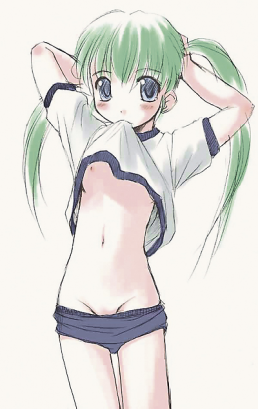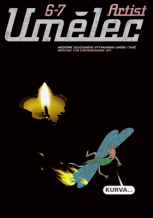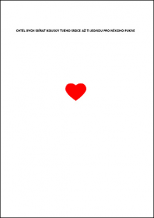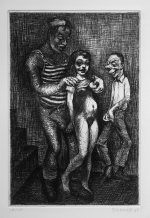| Umělec 2003/2 >> Manga: From Buddhist Scrolls to Big Eyes | Просмотр всех номеров | ||||||||||||
|
|||||||||||||
Manga: From Buddhist Scrolls to Big EyesUmělec 2003/201.02.2003 Pavel Ryška | manga | en cs |
|||||||||||||
|
A search for the true roots of “manga” has brought comics historians back to the 7th century. Like Scott McCloud, who pinpointed the origin of western comics in the Bayeux tapestry, historians in the East located the first manga in scrolls made by Buddhist monks. And as comics don’t necessarily have to be comical, this might be accurate. Religious scrolls and animated stories, “e-monogatari,” are as little comical as they are comic. After all, the narratives of e-monogatari rely on texts and the pictures are only there as illustration.
The origin of the term “manga” itself is another landmark on the journey to the present day sensation of Japanese comics. The first artist to use this word to label his sketches and caricatures was the famous Japanese painter and graphic artist, Hokusai (1760 – 1849). After 1814 he had 12 volumes of sketchbooks published, which soon became very popular among students of drawing techniques. These included sketches of plants, animals or details of human faces, as well as whole-page compositional solutions to different themes. In the master’s own words, it was supposed to contain “everything in space.” In the further development of the genre, unrestrained linear brush technique and the free spreading of motifs on single pages became important. At first sight, Hokusai’s countrymen in kimonos little resemble the big-eyed sexy dolls from modern manga. But, more importantly, the pictures cannot really be called comics either. According to McCloud’s definition, partly borrowed from Will Eisner, comics are “juxtaposed pictorial and other images in deliberate sequence, intended to convey information and/or produce an aesthetic response in the reader.” In Hokusai’s case, then, it’s the roots of a style that are visible, not a media. The idea of the picture serials that we know today invaded Japan from overseas in the first decades of the 20th century. The first cartoonists were obviously influenced by western production, stories like “The Yellow Kids,” published from 1896 in The New York Journal by Richard Outcault. Apart from being the first full-color comic published regularly, this serial is also interesting for its obvious racism. The comic show the lives of the protagonists in suburban slums; the little rascals in long yellow shirts are a clear parody of Chinese immigrants. The first Japanese authors of original comics, like the caricaturist Ippei Okamoto (1886 – 1948), greatly admired American comics, and they helped to promote the art form in Japan (Okamoto himself promoted Bud Fisher’s Mutt and Jeff). Thanks to their enthusiasm, the animated story became a common part of the daily press. Less successful was the attempt to use the Japanese-adapted version of the English “comic” — komikk. The established term “manga,” which today is a combination of two kanji characters, “MAN” meaning casual, free, fancy and “GA” meaning “picture,” was used at the end of the 40’s in reference to the work of the great creator of modern manga, Osamu Tezuka. Osamu Tezuka: Modern Master At first sight his works look nothing like the old Japanese graphics that enchanted French painters at the end of the 19th century. Nevertheless, his work is still partly coasting on the legacy of Japanese masters. Despite his love for Walt Disney, and his ability to draw even bigger eyes on his heroes than Mickey Mouse’s, his work was also influenced by European comics, especially by Hergé, the father of the modern European comic book. It is not true, as is often said, that manga (or Japanese comics) was created in direct connection with overseas production. Some say it was even stolen from the West. In fact, Osamu Tezuka came from a tradition of Japanese drawing, which he enriched with what he admired in American animated stories. His heroes’ conspicuous big eyes became not only a distinctive feature of his style, but in his hands they were molded into a medium capable of expressing a wide scale of emotions. Tezuka also managed to infuse the scenes with new motion dynamics. Japanese animated stories to that time offered mostly static scenes in which a few actors played out their roles. (Their American counterparts had a similar position. The more convincing and dynamic compositions were being elaborated approximately at the same time by the geniuses of the genre Will Eisner or Jack Kirby). In this way Osamu Tezuka became the real father of modern manga. Japanese cartoonists soon began to adopt the American system of page segmentation of using individual patches. But once again it was the ingenious Tezuka who developed the hidden possibilities within this specific kind of narration. Tezuka’s big love was movies, especially German and French. His passion for film narratives in which not only the dialogues, but also the images, help move the story forward, was visible in his first work, New Treasure Island. Using the themes of R. L. Stevenson’s novel, Tezuka drew an adventure story whose first eight pages (of a total of 180) “describe” in film language (including “cutaway” shots, combining details with “long shots”) the arrival of the main hero, catching the departing ship. Thanks to this, Japanese comics are often considered “cinematic,” which is not entirely accurate. Only in Japanese comics can one find so many bravely dynamic whole page (or two page) compositions. The New Treasure Island was created by Osamu Tezuka, when he was a 19-year-old student of medicine. Till then, only children read comics and Tezuka himself was aiming at children readers. But then he took a courageous step: ten years after the war ended in the atomic destruction of Japan, he dared to create a figure of a boy-robot with an atomic heart, Tetsuwana, known in the West as Astro Boy. The energy that powered his adolescent body in the fight against all war mongers and which radiated from his big glowing eyes was the very same that had wiped two Japanese cities off the earth. Astro Boy was successful primarily as a TV series, and in Australia it was broadcast into the 70’s. The young readers (and since the end of the 1950’s, viewers of animated series) were now growing up, but they did not want to give up their beloved volumes of animated stories. They carried them to high school, then to university. But Manga they left behind. Grownup readers could no longer stomach the repetitive theme of good and bad boys, and their respective gangs, fighting. When in the 70’s Tezuka’s admirers themselves became authors of comics, manga ceased to be exclusively for children. The robots, too, had changed since the time of Tetsuwana. The big era of sci-fi smoothly transformed into more or less dark cyber-punk visions. The present span of manga genres from classic novel adaptations to horror (e.g. the bloodfest Hell Baby by Hideshi Hino) is fascinating, as is the sheer volume of regularly published magazines. There is manga for boys and manga for girls, special editions for teenagers and women, manga is read by schoolchildren as well as adult Japanese. Kodomo is manga for youth, for beginning readers. For boys between six and 18 there is Shonen manga, for girls of the same age Shoujo manga. Older readers read Seinen manga, women between 15 and 40 Redisu. The periodicals are divided according to age groups, but adults often borrow schoolchildren’s magazines and pupils exchange the pornographic hentai and ecchi. Next to entertainment genres there are educational comics, published since 1964 by the magazine Garo, meant for the study of history. Its first story by Sampei Shirata was a “historical fresco” about the battles between the social groups of feudal Japan. Manga Market Forces The success of Osama Tezuka’s work spawned a new generation of cartoonists who follow his style and supply the ever growing community of comics consumers with new stories. Up to the end of the last millenium, manga had become such a huge and progressive market that it not only fascinated the West, but also overshadowed comic superpowers USA and France. If at the end of the 1940’s the mere 400,000 sold issues of New Treasure Island meant an unusual commercial success, at the beginning of the 1990’s manga constituted nearly a quarter of the press output of Japan. In a country of 120 million people, this represents 2000 yen a year per person only for manga. It would seem that such a wide market ought to employ hundreds of cartoonists. About 3,000 people actively work in comics, but only about a tenth of them can scrape together a living with their own work. Success in this market means publishing in official periodicals. And unfortunately recent attempts to circumvent the established publishing practices by making web sites where “micro-pay” was supposed to solve the problem of raising capital for the printed version never really worked out. On the other hand, market success is not the only motivation for cartoonists. Manga offers an instant solution for new authors — a wide range of expressive means, clear rules, and at the same time relatively free content, a polished style that is accepted by a huge community of readers and viewers. A large number of underground publications also come out in Japan, though most only have a single run. Amateur or independent cartoonists have gained a new platform for their publications with the development of the web. Besides on-line comics, nearly every current internet manga and anime page also presents dojinshi, or fan-art, or contributions by amateur cartoonists. These attempts range from imitating successful authors to producing “different” style variations. The production of amateur cartoonists appearing on the web is mostly freely accessible and does not compete with the market. As the work often contains openly sexual content (though not directly pornographic), it seems as if the artists are avoiding direct contact with the market, as sex in official production is a taboo. And not only in Japan. In the American edition of the stories Section 9 (“Ghost in the Shell”) all the sexually tense scenes were censured. The official manga industry is currently running on full throttle. The system of editing comics in Japan is very elaborate and fully democratic. New authors are published in anthologies measuring from 250 to 1200 pages. These corpulent paperbacks are printed in black and white on a low-quality wood paper, slightly tinted pink or green. Successful pilot stories are later made into single printouts of 200 pages in full color on fine paper. The most successful stories are made into anime (animated TV series) or adapted as film versions. The most successful story of the 90’s — “Ghost in the Shell,” created in 1991 by cartoonist and script writer Masamune Shirow — made such a journey. The story takes place in the near future. Motoko Kusanagi, code name Major, and her team Section 9, a special police department of the town Newport, solve various crimes. “Ghost in the Shell” is quite unusual for manga and in many ways a turning point: It does not tell the story mainly with pictures, as is usual in Japan, instead it uses many written descriptions, and in places even resembles a manual with technical instructions — e.g. detailed descriptions on how to make a cybernetic body. A series of scenes will “build” an atmosphere rather than tell a story. Shirow’s manga appeared in 1995 in a film version, with Director Mamoru Oshii picking a dark, rainy story from Section 9, “The Puppeteer.” The success of the movie raised a new wave of interest in the original comics, and ten years after the first series manga, “Ghost in the Shell” appeared in 2001 for the second time, titled “Man-machine Interface.” This work is the crown jewel of the genre, at least from the point of view of technical production. The question is, to what extent will formal finish, which requires demanding technological support and team collaboration, be more and more precise at the expense of the story’s quality. In my opinion, there is no such “indirect proportion.” Ferry van Vosselen, Belgian comics artist who is also a teacher of comics, sounds quite convincing when he tells his students, as he is known to do, that it is possible to sell a good story with not so good pictures — with a little bit of luck — but no one will buy beautiful pictures with a stupid story. DIY From this point of view, the greatest virtues of manga are the clearly defined rules, which can be easily adopted. But at the same time this can be a stumbling block. Because manga is one of the most imitated drawing styles of all time, there are many didactic manuals on “How to draw manga,” similar to western manuals instructing neophytes how to paint a landscape or a portrait. Many web pages, e.g. www.howtodrawmanga.com, offer (crash)courses, which would seem to spell the end of this style. Advice exists on how to learn the “basics.” First you need to choose the proper tools. Many still cling to pens, brushes and ink, others work right on a graphic editor. Surprisingly, it is not recommended that you begin with the bulging eyes. It seems that the basics of the style lie in the art of putting single locks of hair into a properly tousled or elegantly windblown hairstyle. A proper placement of the hair seems important. Long hair will hide any mistakes, but with short hair it’s important to get the placement right on the shape of the head. It should look as natural as possible for the animated heroes and heroines. Not only girls can have long hair, which, as opposed to the West, is not an achievement of the 60’s, but a tradition. There are many variation in composition and only a real master can manage to do everything and still launch into experimental forays. Manga is also characterized by dynamics. While depicting motion it is mainly the hairstyle that reflects the personality of the character. Aggression electrifies every strand and changes the hair into an alternative weapon. If the cartoonist knows “which way the wind is blowing,” real wonders an be done, especially with blue hair. A normal wind usually destroys hairstyles. Not the wind blowing in manga. A manga wind can turn an average schoolgirl into an unconquerable fighteress. Eyes are, of course, considered the most expressive detail of the whole character. The drawing starts with the eyebrows, an arched curve, closed at an the angle of 45 degrees on the lower lid, simplified into a line. Between these two lines is the oval of the eye set so that the upper end of the lid is hidden under the eyebrow... Try it yoursef. If you are anything of a craftsperson, you should be able to draw a good picture! Manga is spreading exponentially and is becoming public property. The internet has suddenly become not only a source for broadening one’s horizons, but also a means for creating new stories, as it spontaneously inserts material into uncharted territory. Who will be more inspiring one day, the founders of new forms or the moderate followers of acknowledged forms, is anyone’s guess.
01.02.2003
Рекомендуемые статьи
|
|||||||||||||
|
04.02.2020 10:17
Letošní 50. ročník Art Basel přilákal celkem 93 000 návštěvníků a sběratelů z 80 zemí světa. 290 prémiových galerií představilo umělecká díla od počátku 20. století až po současnost. Hlavní sektor přehlídky, tradičně v prvním patře výstavního prostoru, představil 232 předních galerií z celého světa nabízející umění nejvyšší kvality. Veletrh ukázal vzestupný trend prodeje prostřednictvím galerií jak soukromým sbírkám, tak i institucím. Kromě hlavního veletrhu stály za návštěvu i ty přidružené: Volta, Liste a Photo Basel, k tomu doprovodné programy a výstavy v místních institucích, které kvalitou daleko přesahují hranice města tj. Kunsthalle Basel, Kunstmuseum, Tinguely muzeum nebo Fondation Beyeler.
|












































 New book by I.M.Jirous in English at our online bookshop.
New book by I.M.Jirous in English at our online bookshop.
Комментарии
Статья не была прокомментированаДобавить новый комментарий